This article needs additional citations for verification .(July 2018) |

Jarai-ka-Math is a temple dedicated to Goddess Laxmi in Barua sagar near Jhansi in Uttar Pradesh, India.
This article needs additional citations for verification .(July 2018) |

Jarai-ka-Math is a temple dedicated to Goddess Laxmi in Barua sagar near Jhansi in Uttar Pradesh, India.
Jarai-ka-Math was built by the Gurjara-Pratihara ruler Mihira Bhoja. The temple dates backs to approximately 860 AD, this red sandstone temple is a pancharata shrine of the Panchayatan type, in which the main temple is surrounded by four subsidiary shrines at the four corners. Declared a protected monument by the Archaeological Survey of India in 1928, the temple is an excellent example of early Gurjara-Pratihara architecture.[ citation needed ]
The temple is a repercussion to the vigorous temple-building activity which became a characteristic feature of the Chandellas. The temple is dedicated to Devi (Laxmi) whose multifarious forms are represented in the profusely carved sculptures along the temple walls. The temple stands on elevated ground dominating its surroundings. The main image of the deity is missing from the sanctum sanctorum. Only the pedestal, and the jeweled right foot of a female placed on a lotus stalk, remains. This detail is traditionally associated with the goddess Tara or Mateswari. The placement of a miniature, sixteen-armed image of a goddess on the central lintel of the entrance further supports the conjecture that the temple is dedicated to a goddess. Erotic sculptures, akin to those at Khajuraho, also grace the Jarai-ka-Math.

The Dilwara Temples or Delvada Temples are a group of Śvētāmbara Jain temples located about 2+1⁄2 kilometres from the Mount Abu settlement in Sirohi District, Rajasthan's only hill station. The earliest were built by Bhima-1 and supposedly designed or at least financed by Vastupala, Jain minister of Dholka. They date between the 11th and 16th centuries, forming some of the most famous monuments in the style of Māru-Gurjara architecture, famous for their use of a very pure white marble and intricate marble carvings. They are managed by Seth Shri Kalyanji Anandji Pedhi, Sirohi and are a pilgrimage place for Jains, and a significant general tourist attraction. Although Jains built many temples at other places in Rajasthan, the Dilwara temples are believed to be the most impressive.

The Gurjara-Pratihara was a dynasty that ruled much of Northern India from the mid-8th to the 11th century. They ruled first at Ujjain and later at Kannauj.

Osian is an ancient town located in the Jodhpur District of Rajasthan state in western India. It is an oasis in the Thar Desert. The town is a panchayat village and the headquarters for Osian tehsil. It lies 69 km (43 mi) by road north of the district headquarters at Jodhpur, on a diversion off the main Jodhpur – Bikaner Highway. The under-construction Amritsar Jamnagar Expressway passes through this town.

Bhinmal is an ancient town in the Jalore District of Rajasthan, India. It is 72 kilometres (45 mi) south of Jalore. Bhilmal was the capital of the Bhil king, then the capital of Gurjaradesa, comprising modern-day southern Rajasthan and northern Gujarat.
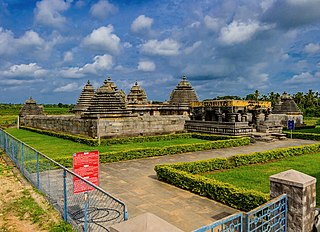
The Lakshmi Devi temple is an early 12th-century Hindu temples complex located in Doddagaddavalli village in Hassan District, Karnataka India. The main temple consists of four-shrines that share a common mandapa (hall), each sanctum being a square and aligned to a cardinal direction. The eastern shrine has Goddess Lakshmi, the northern shrine is dedicated to Kali-Durga, the western to Shiva, and the southern is empty and likely Vishnu. The complex has a separate Bhairava shrine to the northeast of the main temple, and four small shrines at the corners inside a nearly square prakara (compound). All nine temples are notable for its pyramidal north Indian style Nagara shikhara – likely an influence from Maharashtra and an evidence of active flow of ideas between the southern, central and northern India. The complex has additional smaller shrines.

Taranga is a Jain pilgrimage center near Kheralu in Mehsana district, Gujarat, India, with two compounds of Jain temples that are important examples of the Māru-Gurjara style of architecture. The Ajitnatha temple, was constructed in 1161 by the Chaulukya king Kumarapala, under the advice of his teacher, Acharya Hemachandra. Both the main sects of Jainism are represented, with adjoining walled compounds: the Svetambara compound consists of 14 temples in all, and there are also five Digambara-affiliated temples at Taranga hill.

Dharmapala (ruled 8th century) was the second ruler of the Pala Empire of Bengal and Bihar regions in the Indian subcontinent. He was the son and successor of Gopala, the founder of the Pala Dynasty. He greatly expanded the boundaries of the empire, and made the Palas a dominant power in the northern and eastern India.

A Jain temple, Derasar or Basadi is the place of worship for Jains, the followers of Jainism. Jain architecture is essentially restricted to temples and monasteries, and Jain buildings generally reflect the prevailing style of the place and time they were built.
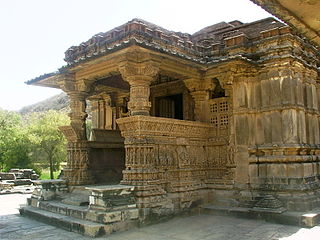
The architecture of the Indian state of Rajasthan has usually been a regional variant of the style of Indian architecture prevailing in north India at the time. Rajasthan is especially notable for the forts and palaces of the many Rajput rulers, which are popular tourist attractions.
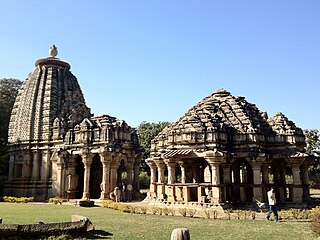
The Baroli Temples Complex, also known as the Badoli temples, is located in Baroli village in Rawatbhata City in Chittorgarh district of Rajasthan, India. The complex of eight temples is situated within a walled enclosure; an additional temple is about 1 kilometre (0.62 mi) away. They are built in the Gurjara Pratihara style of temple architecture dated to the tenth century A.D. And was destroyed by Mughal emperor Aurangzeb during his rajasthan quest. All nine temples are under the control of the Archaeological Survey of India for conservation and protection. A well known art critic characterised "the creations of Badoli as the most perfect of their age that he had encountered within that part of the country and, in their own peculiar style."
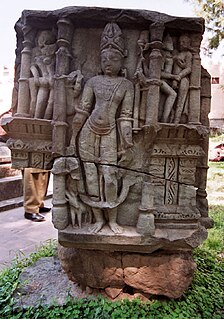
The Bhima Devi Temple Complex, nicknamed Khajuraho of North India for its erotic sculptures, comprises the restored ruins of an ancient Hindu temple dating from between 8th and 11th century AD, together with the adjacent 17th-century Pinjore gardens, located in Pinjore town in Panchkula district of the state of Haryana, India. The old temple was destroyed by Islamic invaders and the present 8-11th CE temple is likely built on the same place under the old name, and the nearby ancient baoli still has old Hindu pillars. Bhimadevi belongs to the Shakti tradition that was derived from the Buddhist tantric goddess. Further, in the Devi Mahatmya it is said that in the Western Himalayas of Himachal Pradesh, Bhimadevi appeared in an enormous form of Bhimarupa and gave protection to the sages. The site was worked upon extensively by the team of Speaking Archaeologically from 2017 to 2019, with preliminary survey beginning as early as in 2015 and the report was published as the Speaking Archaeologically Journal Volume III:Bhima Devi Project Edition in 2020.
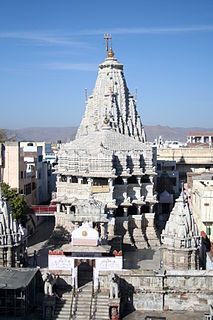
Jagdish Temple is a large Hindu temple in the middle of Udaipur in Rajasthan, just outside the royal palace. It has been in continuous worship since 1651. A big tourist attraction, the temple was originally called the temple of Jagannath Rai but is now called Jagdish-ji. It is a major monument in Udaipur.

The Kalayat Ancient Brick Temple Complex is a ruined brick temple complex north of Delhi, is located in Kalayat town in Kaithal district of the state of Haryana, India. It comprises the several Hindu temples, including two ancient temples dating from the 8th century. This temple constitutes an important point in the series of 48 kos parikrama of Kurukshetra.

Teli ka Mandir, also known as Telika Temple, is a Hindu temple located within the Gwalior Fort in Madhya Pradesh, India. Dedicated to Shiva, Vishnu and Matrikas, it has been variously dated between the early 8th and early 9th century CE.

Māru-Gurjara architecture, Chaulukya style or Solaṅkī style, is the style of West Indian temple architecture that originated in Gujarat and Rajasthan from the 11th to 13th centuries, under the Chaulukya dynasty. Although originating as a regional style in Hindu temple architecture, it became especially popular in Jain temples, and mainly under Jain patronage later spread across India, then later to diaspora communities around the world.

The Khed-Roda Group of Monuments include eighth-ninth century dated seven Hindu temples built during Gurjara-Pratihara or Rashtrakuta period. It also include a reservoir (Kund) and a stepwell. They are located between Raisingpura (Roda) and Khed Chandarani villages, 18 km from Himmatnagar in Sabarkantha district of Gujarat, India. It is located on the bank of the seasonal stream which merges Hathmati river downstream.
Narasimha II was a ruler of the Vemulavada Chalukya dynasty of present-day Telangana, India. As a vassal of the Rashtrakuta king Indra III, he led an Rashtrakuta army against the Gurjara-Pratihara king Mahipala. According to his dynasty's records, he advanced as far as Ganges river in the north, forcing Mahipala to flee.
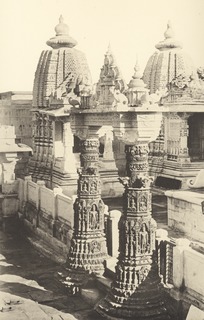
The Mahavira Jain temple is built in Osian of Jodhpur District, Rajasthan. The temple is an important pilgrimage of the Oswal Jain community. This temple is the oldest surviving Jain temple in Western India and was built during the reign of Mahārāja Śrī Vatsarāja of Imperial Pratihāras. The temple is visited by both Jain and Hindu.
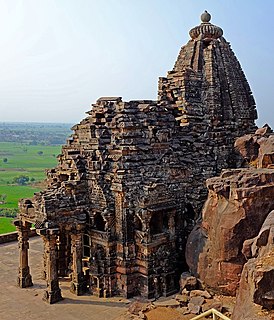
Vidisha is considered to be Puranakshetras Jain tirtha. The Jain temples are located in Vidisha district in state of Madhya Pradesh, India. According to Jain belief, Vidisha is the birthplace of Shitalanatha, the tenth tirthankar. Here the first 108 feet elevated temple with all Tirthankaras with Shitalanatha as the principal deity is under construction.
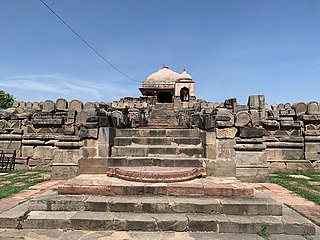
The Harshat Mata Temple is a Hindu temple in the Abhaneri village of Rajasthan, in north-western India. The temple is now dedicated to a goddess called Harshat Mata, although some art historians theorize that it was originally a Vaishnavite shrine.